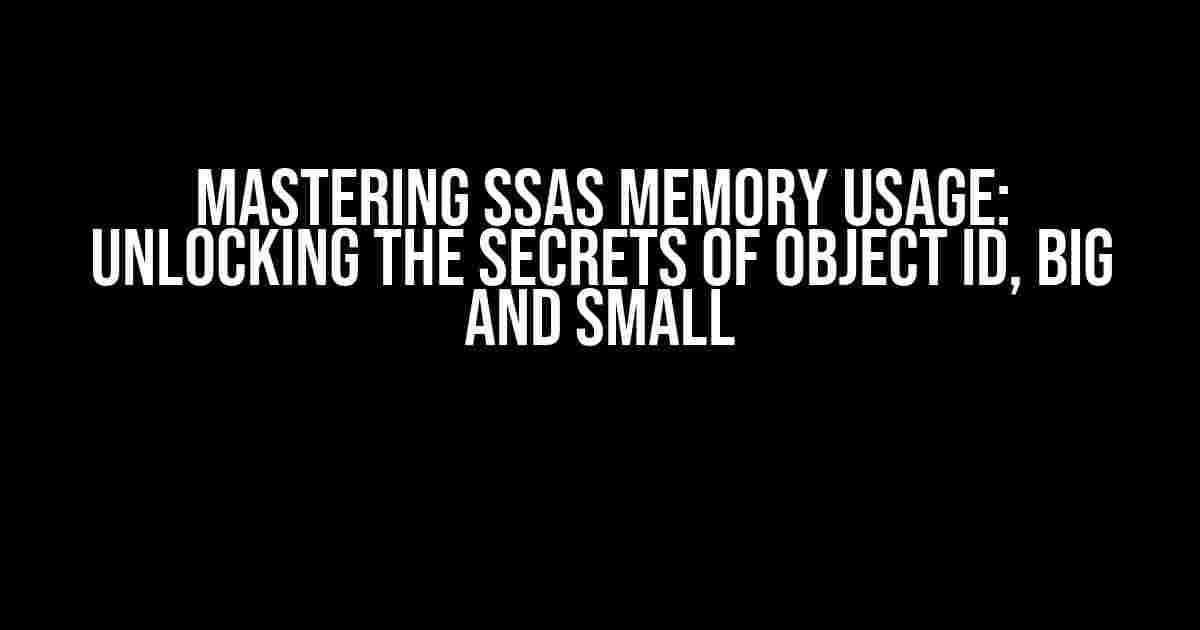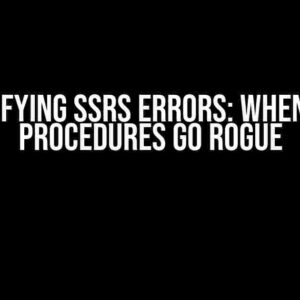Are you tired of dealing with slow-performing SSAS (SQL Server Analysis Services) systems? Do you struggle to troubleshoot memory usage issues? Look no further! In this comprehensive guide, we’ll delve into the world of SSAS memory usage, focusing on the crucial role of Object ID, Big and Small. By the end of this article, you’ll be equipped with the knowledge to optimize your SSAS system’s performance and tackle even the most daunting memory-related challenges.
Understanding SSAS Memory Usage
Before we dive into the specifics of Object ID, Big and Small, it’s essential to understand the basics of SSAS memory usage. SSAS is a robust business intelligence platform that processes and analyzes large datasets to provide insightful reports and visualizations. However, this processing power comes at a cost – memory usage.
SSAS uses a combination of physical memory (RAM) and disk storage to manage data processing. When a query is executed, SSAS allocates memory to store the data and perform calculations. The allocated memory is then divided into two categories:
- Big Memory: Used for storing large datasets, such as fact tables and measure groups.
- Small Memory: Used for storing smaller objects, such as dimensions, hierarchies, and aggregations.
Object ID: The Key to Unlocking SSAS Memory Usage
An Object ID is a unique identifier assigned to each object in an SSAS database. This ID plays a critical role in managing memory usage, as it allows SSAS to track and allocate memory resources efficiently.
To view the Object ID of an object, follow these steps:
1. Open SQL Server Management Studio (SSMS) and connect to your SSAS instance. 2. In the Object Explorer, right-click on the object you want to view (e.g., a measure group or dimension). 3. Select "Properties" from the context menu. 4. In the Properties window, look for the "ID" property, which displays the Object ID.
Big and Small Object IDs: A Deeper Dive
Object IDs can be further categorized into Big and Small IDs, depending on the type of object and its memory usage.
Big Object IDs
Big Object IDs are assigned to objects that consume large amounts of memory, such as:
- Measure groups
- Fact tables
- Large dimensions
Big Object IDs typically have higher values (e.g., 10000+) and are stored in the dboBigObject system table.
Small Object IDs
Small Object IDs are assigned to objects that consume relatively small amounts of memory, such as:
- Dimensions
- Hierarchies
- Aggregations
Small Object IDs typically have lower values (e.g., 1-9999) and are stored in the dboSmallObject system table.
Optimizing SSAS Memory Usage with Object ID
Now that you understand the role of Object ID in SSAS memory usage, let’s explore some strategies to optimize memory allocation:
- Monitor Object ID usage: Regularly review the Object ID allocation to identify objects consuming excessive memory. Use the
dboObjectSizesystem table to track object sizes. - Implement data compression: Compressing data can significantly reduce memory usage. Use the
compressionproperty to enable data compression for large objects. - Optimize data processing: Optimize data processing by using efficient algorithms, reducing data duplication, and minimizing data transformation.
- Use caching strategically: Caching can improve performance, but it also consumes memory. Use caching strategically to balance performance and memory usage.
- Partition and aggregate data: Partitioning and aggregating data can reduce memory usage and improve performance. Use SSAS partitioning and aggregation features to optimize data storage.
Common Issues with SSAS Memory Usage and Object ID
Even with proper optimization, SSAS memory usage issues can still arise. Here are some common problems and their solutions:
| Issue | Solution |
|---|---|
| High memory usage due to large objects | Implement data compression, partitioning, and aggregating data to reduce object sizes. |
| Memory allocation issues due to incorrect Object ID | Verify Object ID allocation and adjust as necessary. Ensure correct object types and memory allocation. |
| Insufficient memory for query processing | Optimize query processing by reducing data complexity, using efficient algorithms, and allocating additional memory resources. |
Conclusion
Mastering SSAS memory usage requires a deep understanding of Object ID, Big and Small. By following the strategies and techniques outlined in this article, you’ll be well-equipped to optimize your SSAS system’s performance, troubleshoot memory-related issues, and unlock the full potential of your business intelligence platform.
Remember, SSAS memory usage is a complex and dynamic process. Continuously monitor and adjust your optimization strategies to ensure optimal performance and memory allocation.
Stay ahead of the curve and become an SSAS memory usage expert. Start optimizing your system today and unlock the power of business intelligence!
Frequently Asked Question
Get the inside scoop on SSAS memory usage Object ID Big and Small!
What is an Object ID in SSAS and why is it important?
In SSAS, an Object ID is a unique identifier assigned to each object, such as a cube, dimension, or measure group. It’s crucial because it helps the server efficiently locate and manage objects, reducing memory usage and improving performance. Think of it like a librarian keeping track of books on shelves – the Object ID is the book’s “address” in the SSAS library!
What’s the difference between a Big and Small Object ID in SSAS?
In SSAS, Object IDs can be either Big or Small. Big Object IDs are used for large objects that consume more memory, such as cube data, while Small Object IDs are used for smaller objects like dimension members or measure groups. Think of it like filing cabinets – Big Object IDs are like the big, sturdy filing cabinets that hold lots of files, while Small Object IDs are like the smaller, more compact ones that hold fewer files.
How do I optimize SSAS memory usage by managing Object IDs?
To optimize SSAS memory usage, make sure to regularly clean up unused objects, reduce the number of objects with large datasets, and consider consolidating small objects into larger ones. You can also use tools like the SSAS Memory Usage dashboard to monitor and analyze Object ID usage. By keeping your Object IDs in check, you’ll free up memory and improve overall performance – it’s like decluttering your digital desk!
Can I change an Object ID in SSAS, and if so, how?
Yes, you can change an Object ID in SSAS, but be careful – it’s like changing the address on a package! You’ll need to use the Alter command in the SSAS Management Studio or the SSAS PowerShell module. Make sure to update any references to the original Object ID to avoid errors. It’s also a good idea to test your changes in a development environment before deploying to production.
What are some best practices for managing Object IDs in SSAS development?
When developing in SSAS, follow best practices like using meaningful and consistent naming conventions for your objects, avoiding duplicate names, and regularly reviewing and cleaning up unused objects. You should also consider implementing a version control system to track changes to your objects and Object IDs. By following these tips, you’ll keep your Object IDs organized and your SSAS project running smoothly – it’s like keeping your digital house in order!



